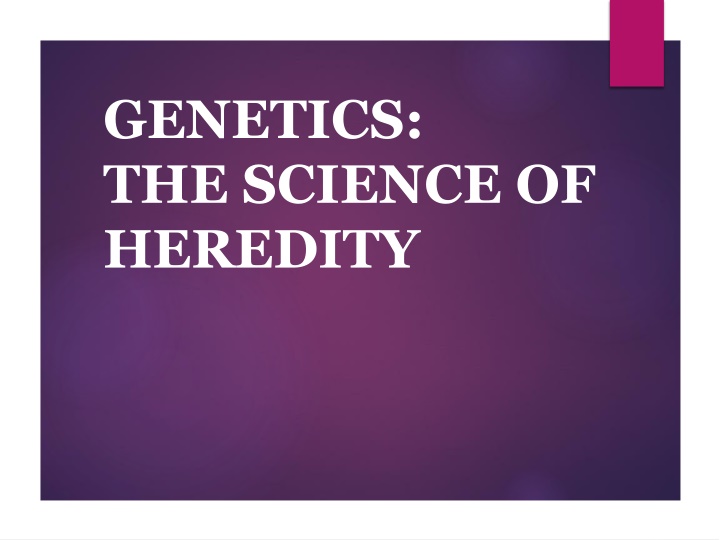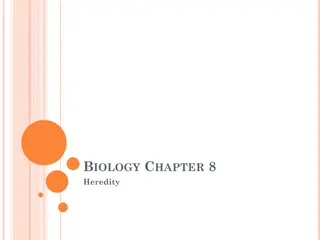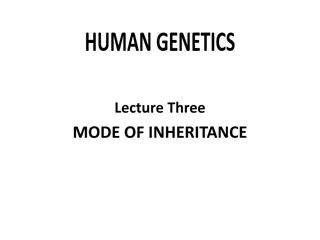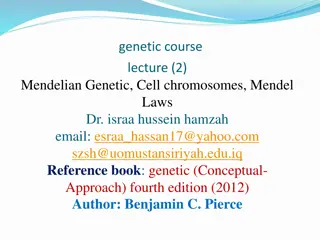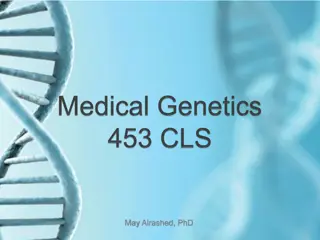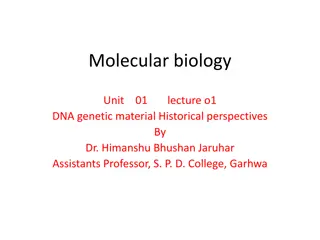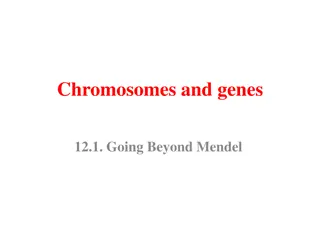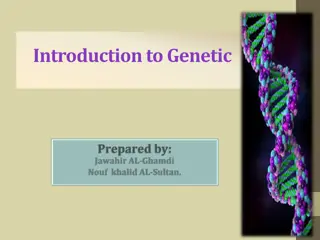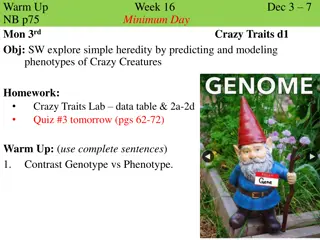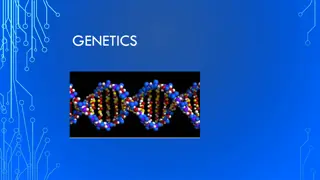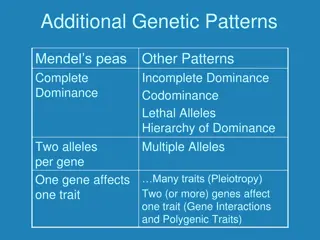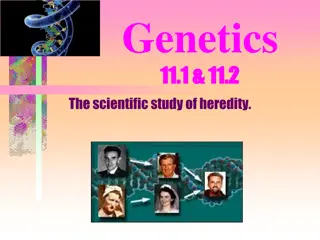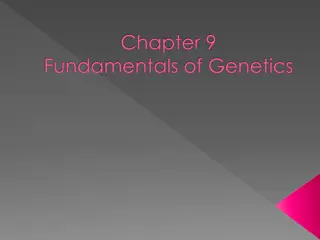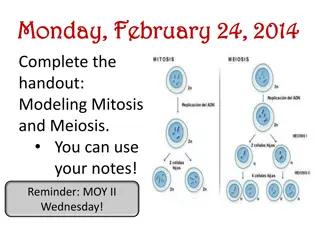The Science of Heredity and Mendel's Discoveries
Genetics is the scientific study of heredity, focusing on how traits are passed down from parents to offspring. Gregor Mendel, an Austrian monk, made significant contributions to genetics using garden peas. He discovered the principles of inheritance, such as true-breeding traits and the laws of segregation and independent assortment. Mendel's experiments with pea plants laid the foundation for our understanding of genetics and the role of genes in determining inherited traits.
Uploaded on Feb 26, 2025 | 0 Views
Download Presentation

Please find below an Image/Link to download the presentation.
The content on the website is provided AS IS for your information and personal use only. It may not be sold, licensed, or shared on other websites without obtaining consent from the author.If you encounter any issues during the download, it is possible that the publisher has removed the file from their server.
You are allowed to download the files provided on this website for personal or commercial use, subject to the condition that they are used lawfully. All files are the property of their respective owners.
The content on the website is provided AS IS for your information and personal use only. It may not be sold, licensed, or shared on other websites without obtaining consent from the author.
E N D
Presentation Transcript
GENETICS: THE SCIENCE OF HEREDITY
File:Gregor Mendel.png The Work Of Gregor Mendel
GENETICS IS THE SCIENTIFIC STUDY OF HEREDITY Heredity the passing on of characteristics from parents to offspring. Hybridogenesis in water frogs gametes.gif These characteristics are called traits. Photo by Darekk2 / CC BY-SA
Gregor Mendel, an Austrian monk, discovered important facts about heredity using garden peas. Garden peas produce male and female sex cells called gametes. Peas, Vegetable, Healthy, Health, Fitness, Summer, Food Fertilization occurs when the male and female reproductive cells join forming a zygote. The zygote becomes part of a seed.
MENDEL USED TRUE-BREEDING PEAS, MEANING IF THEY WERE ALLOWED SELF SELF-POLLINATE, THEY WOULD PRODUCE OFFSPRING IDENTICAL TO THEMSELVES. Mendel studied seven traits of pea plants, but only studied ONE trait at a time, for example to see how height was passed from parent to offspring. Mendel took pollen from a true-breeding tall pea plant and cross-pollinated a true-breeding short pea plant.
Dog, Hybrid, Funny, Pet, Animal, Fur, Brown, White Hybrid Offspring of parents that have different forms of a trait. Since only one trait was different the offspring is called a monohybrid. Parents Offspring Offspring of F1 generation P1 generation F1 generation F2 generation
Mendels Laws Of Heredity
Mendels Laws of Heredity Mendel concluded that biological inheritance is determined by factors that are passed from one generation to the next. These factors that determine traits are called genes. Alleles different forms of genes, such as genes for height can either produce genes for tall plants or genes for short plants.
FIRST LAW File:Mendelian inheritance.svg Law of Segregation every organism has two alleles of each gene -when gametes are produced the alleles separate.
PHENOTYPE THE WAY AN ORGANISM LOOKS AND BEHAVES (TALL OR SHORT) GENOTYPE THE ALLELE COMBINATION OF AN ORGANISM (TT, Tt, tt) AN ORGANISM IS HOMOZYGOUS FOR A TRAIT IF THE TWO ALLELES FOR THE TRAIT ARE THE SAME. TT TT HOMOZYGOUS DOMINANT t tt t HOMOZYGOUS RECESSIVE AN ORGANISM IS HETEROZYGOUS FOR A TRAIT IF ITS TWO ALLELS FOR THE TRAIT ARE DIFFERENT Tt
SECOND LAW Law of Independent Assortment genes for different traits are inherited independently of each other. *In a dihybrid cross (two traits) you can see both of Mendel s Laws at work.
Reginald Punnett came up with Punnett Squares -To predict the proportions of possible genotypes in offspring. one parent s genotype T t Punnett square for a single trait T t other parent s genotype
Monohybrid Cross Heterozygous Plants Crossing two pea plants that are heterozygous for seed color (Tt) will produce offspring in the following ratio: Parent 1 (Tt) x Parent 2 (Tt) T t T TT Tt 1/4 = TT (Homozygous Dominant) 2/4 = Tt (Heterozygous) 1/4 = (Homozygous recessive) t Tt tt
Monohybrid Cross Homozygous Plants A cross between a yellow homozygous plant (TT) with a homozygous recessive green plant (tt) only produces heterozygous yellow (Tt) offspring. 4/4 = Tt (Heterozygous) T T t Tt Tt *A Punnett square can also be created for dihybrid crosses it would be four boxes wide and four boxes tall. t Tt Tt
Meiosis a type of cell division that produces four cells, each with half the number of chromosomes as the parent cell. In animals, meiosis occurs in the sex organs the testes in males and the ovaries in females. File:Meiosis Overview.svg
A gamete, or sex cell is a haploid cell, meaning this cell contains only one of each kind of chromosomes versus a diploid cell found in body cells, which have two of each kind of chromosome.
*Mitosis results in the production of two genetically identical diploid cells, whereas meiosis produces four genetically different haploid cells in two stages known as the 1st and 2nd meiotic divisions. File:Major events in mitosis.svg
